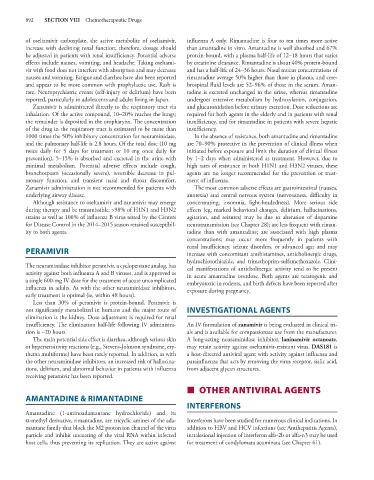Page 906 - Basic _ Clinical Pharmacology ( PDFDrive )
P. 906
892 SECTION VIII Chemotherapeutic Drugs
of oseltamivir carboxylate, the active metabolite of oseltamivir, influenza A only. Rimantadine is four to ten times more active
increase with declining renal function; therefore, dosage should than amantadine in vitro. Amantadine is well absorbed and 67%
be adjusted in patients with renal insufficiency. Potential adverse protein-bound, with a plasma half-life of 12–18 hours that varies
effects include nausea, vomiting, and headache. Taking oseltami- by creatinine clearance. Rimantadine is about 40% protein-bound
vir with food does not interfere with absorption and may decrease and has a half-life of 24–36 hours. Nasal mucus concentrations of
nausea and vomiting. Fatigue and diarrhea have also been reported rimantadine average 50% higher than those in plasma, and cere-
and appear to be more common with prophylactic use. Rash is brospinal fluid levels are 52–96% of those in the serum. Aman-
rare. Neuropsychiatric events (self-injury or delirium) have been tadine is excreted unchanged in the urine, whereas rimantadine
reported, particularly in adolescents and adults living in Japan. undergoes extensive metabolism by hydroxylation, conjugation,
Zanamivir is administered directly to the respiratory tract via and glucuronidation before urinary excretion. Dose reductions are
inhalation. Of the active compound, 10–20% reaches the lungs; required for both agents in the elderly and in patients with renal
the remainder is deposited in the oropharynx. The concentration insufficiency, and for rimantadine in patients with severe hepatic
of the drug in the respiratory tract is estimated to be more than insufficiency.
1000 times the 50% inhibitory concentration for neuraminidase, In the absence of resistance, both amantadine and rimantadine
and the pulmonary half-life is 2.8 hours. Of the total dose (10 mg are 70–90% protective in the prevention of clinical illness when
twice daily for 5 days for treatment or 10 mg once daily for initiated before exposure and limit the duration of clinical illness
prevention), 5–15% is absorbed and excreted in the urine with by 1–2 days when administered as treatment. However, due to
minimal metabolism. Potential adverse effects include cough, high rates of resistance in both H1N1 and H3N2 viruses, these
bronchospasm (occasionally severe), reversible decrease in pul- agents are no longer recommended for the prevention or treat-
monary function, and transient nasal and throat discomfort. ment of influenza.
Zanamivir administration is not recommended for patients with The most common adverse effects are gastrointestinal (nausea,
underlying airway disease. anorexia) and central nervous system (nervousness, difficulty in
Although resistance to oseltamivir and zanamivir may emerge concentrating, insomnia, light-headedness). More serious side
during therapy and be transmissible, >98% of H1N1 and H3N2 effects (eg, marked behavioral changes, delirium, hallucinations,
strains as well as 100% of influenza B virus tested by the Centers agitation, and seizures) may be due to alteration of dopamine
for Disease Control in the 2014–2015 season retained susceptibil- neurotransmission (see Chapter 28); are less frequent with riman-
ity to both agents. tadine than with amantadine; are associated with high plasma
concentrations; may occur more frequently in patients with
renal insufficiency, seizure disorders, or advanced age; and may
PERAMIVIR increase with concomitant antihistamines, anticholinergic drugs,
hydrochlorothiazide, and trimethoprim-sulfamethoxazole. Clini-
The neuraminidase inhibitor peramivir, a cyclopentane analog, has cal manifestations of anticholinergic activity tend to be present
activity against both influenza A and B viruses, and is approved as in acute amantadine overdose. Both agents are teratogenic and
a single 600-mg IV dose for the treatment of acute uncomplicated embryotoxic in rodents, and birth defects have been reported after
influenza in adults. As with the other neuraminidase inhibitors, exposure during pregnancy.
early treatment is optimal (ie, within 48 hours).
Less than 30% of peramivir is protein-bound. Peramivir is
not significantly metabolized in humans and the major route of INVESTIGATIONAL AGENTS
elimination is the kidney. Dose adjustment is required for renal
insufficiency. The elimination half-life following IV administra- An IV formulation of zanamivir is being evaluated in clinical tri-
tion is ~20 hours. als and is available for compassionate use from the manufacturer.
The main potential side effect is diarrhea, although serious skin A long-acting neuraminidase inhibitor, laninamivir octanoate,
or hypersensitivity reactions (e.g., Stevens-Johnson syndrome, ery- may retain activity against oseltamivir-resistant virus. DAS181 is
thema multiforme) have been rarely reported. In addition, as with a host-directed antiviral agent with activity against influenza and
the other neuraminidase inhibitors, an increased risk of hallucina- parainfluenza that acts by removing the virus receptor, sialic acid,
tions, delirium, and abnormal behavior in patients with influenza from adjacent glycan structures.
receiving peramivir has been reported.
■ OTHER ANTIVIRAL AGENTS
AMANTADINE & RIMANTADINE
INTERFERONS
Amantadine (1-aminoadamantane hydrochloride) and its
α-methyl derivative, rimantadine, are tricyclic amines of the ada- Interferons have been studied for numerous clinical indications. In
mantane family that block the M2 proton ion channel of the virus addition to HBV and HCV infections (see Antihepatitis Agents),
particle and inhibit uncoating of the viral RNA within infected intralesional injection of interferon alfa-2b or alfa-n3 may be used
host cells, thus preventing its replication. They are active against for treatment of condylomata acuminata (see Chapter 61).

